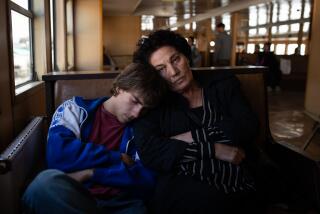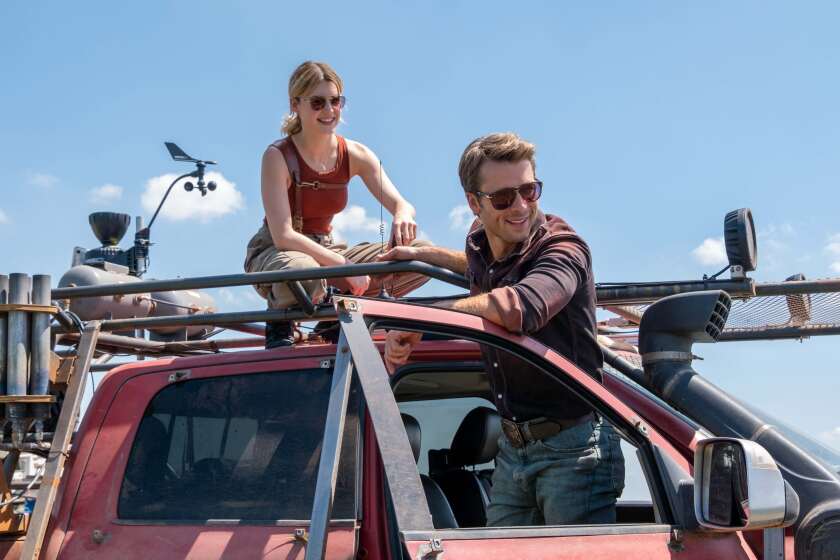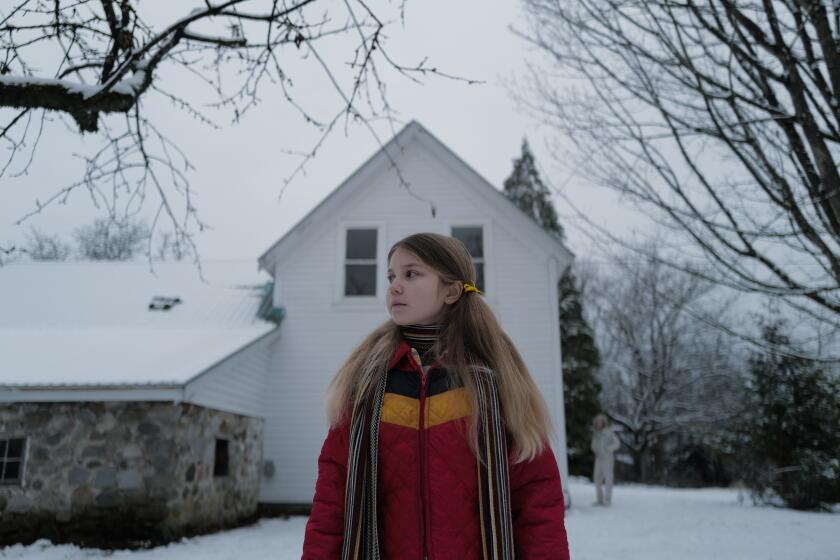Addressing, at Long Last, a Question of Identity
In “A Price Above Rubies,” which opened Friday, Renee Zellweger plays a free-spirited Jewish housewife and mother who challenges her Orthodox faith and struggles with sexual desire.
In “The Truce,” opening next month, John Turturro plays Primo Levi, the celebrated Jewish Auschwitz survivor who reclaims his life and humanity during his painful journey back to his Italian homeland.
And in “The Governess,” which opens in July, Minnie Driver plays a distraught Jew in pre-Victorian England who hides her faith to earn a living, and also struggles with sexual desire.
Something’s definitely in the air, as a group of talented filmmakers turn the cameras on the Jewish heritage in vastly different directions, displaying a range of expression and experience rarely seen on screen--and utilizing three very talented and very hot actors.
The first indication was at this year’s Sundance Film Festival, where, in addition to “A Price Above Rubies,” there were several Jewish-themed films screened, most notably “Pi,” which won the dramatic directing award for its depiction of a math genius obsessed with deciphering the root of pi to unlock the mystery of the Messiah.
But why this sudden profusion of independent Jewish films now? Could it be the lasting residue from the phenomenal success of “Schindler’s List”? Or the fortuitous timing of the 50th anniversary of Israel’s statehood? Or merely a creative coincidence?
For the filmmakers of “A Price Above Rubies,” “The Truce” and “The Governess,” the answer is the latter, though they’re willing to concede that “Schindler’s List” may have had an impact on the financing and distribution of their films. Yet all three insist that it was their passion that successfully brought their projects to the screen--a passion crucially shared by Zellweger, Turturro and Driver. “You do all this meticulous research, but in the end it becomes all about you--intimate, personal, a kind of selfish passion, a need to connect,” says Boaz Yakin, the controversial writer-director of “A Price Above Rubies.”
That certainly describes Yakin’s alienated female protagonist, who tires of her unloving husband (Glenn Fitzgerald)--too absorbed in praying and the Talmud to satisfy her needs--and embarks on an affair with her seductive brother-in-law (Christopher Eccleston), who first hires her to be his jewelry buyer. However, she soon rejects his blatant selfishness and discovers her true passion and value through a romantic involvement with an unconventional Puerto Rican sculptor (Allen Payne).
Obviously not intended as a rosy celebration of the joys of Hasidism, “A Price Above Rubies” has predictably elicited outrage from the Borough Park Orthodox community in New York where the film takes place and where it was shot. A large and angry crowd of Hasidic Jews even drove the film crew out of the Brooklyn neighborhood last year. Then there was a small but vociferous protest more recently at the Manhattan offices of distributor Miramax Films, proclaiming negative stereotyping and anti-Jewish sentiment.
Yakin, who made his directorial debut with “Fresh,” suggests his Hasidic depiction “is actually 10 degrees right of society. It’s not that exotic, at the end of the day. When you get underneath it, it’s a tight society. It’s not utterly painful and restrictive. But I felt any kind of restriction, any kind of need to conform, can be very difficult on certain people. Obviously there are many happy Hasidic women out there, but it can be hard on some.”
Zellweger’s character is confused from the outset, when she and her brother try to repress their incestuous feelings as children in a fairy tale-like prologue and he tragically dies because he can no longer confront them. Later, as an adult, when she can no longer contain her sexual desire, she persists in keeping his memory alive, engaging in therapeutic dialogues with his spirit. And as if to confirm her worst fears about her future status in the Orthodox community, she continually encounters a ubiquitous beggar woman, who’s become an outcast because of her sexual promiscuity.
Yakin says he’s always been attracted to the theme of the outsider, having experienced the conflict himself. Despite a secular upbringing at home, the 32-year-old filmmaker attended Orthodox schools (yeshivas) through ninth grade. At home, with parents from the theater, he encountered an environment of creative individuality, while at school he encountered a more formal environment of communal conformity.
“I’ve had a few people say there’s so much joy in the Hasidic world,” Yakin adds. “How come none of it comes through? I’m building a story through a certain character’s point of view. She’s a woman who, essentially from the very beginning, has an intense romantic love for her brother--romantic in the 18th century idealistic sense of the word. And that’s taken away from her as a little girl. And the joys of the Hasidic community often tend to be communal joys. They don’t emphasize personal, selfish, romantic needs.”
Rabbi Rachel Sabath, of the New York-based National Jewish Center for Learning and Leadership, endorses “A Price Above Rubies.” Although not Orthodox, she has already screened the film at one of her conferences. Sabath endorses its very accurate depiction of the evening Sabbath at home, the conflict between sexuality and Torah, and the role of women with limited choices in an extremely traditional community.
At the same time, though, Sabath worries that non-Jews may misunderstand the film’s message that outsiders are shunned if they don’t conform, and disagrees with a basic theological issue: “When she tells the psychologist about her suffering an odyssey of identity and that she doesn’t buy into any of this, it’s unfortunate,” Sabath says. “Survivors of the Holocaust suffered a crisis of identity too.”
Indeed, that’s the thrust of “The Truce,” based on Levi’s memoir. The film traces his liberation from Auschwitz as he travels the rough roads of Central Europe with fellow survivors from different ethnic backgrounds. Thus, it’s a celebration of both the individual and communal spirit, filmed in the spirit of Italian neo-realism. Levi begins as a figurative ghost, but slowly reclaims his identity, his sexuality and his humanity through vigilance, optimism and
humor. Francesco Rosi, the 75-year-old Italian director, who has worked with the likes of Luchino Visconti and Michelangelo Antonioni, has passionately pursued this project for more than a decade, and continues to be consumed by Levi’s spiritual odyssey.
“I’m still a prisoner of Levi’s book,” Rosi says through an interpreter. “I made a call to him in 1987 and told him I wanted to make this film. He was very happy because what I was doing was giving light to a very dark part of his existence. A week later he committed suicide. He was an optimist but experiences such as Auschwitz never abandon a man. I remained intent. It was difficult to make until a stalemate was broken by ‘Schindler’s List.’ I felt it was extremely important to give the greatest possible circulation to his story because we must never forget the crimes against humanity.”
Rosi believes “The Truce” begins where “Schindler’s List” ends, with both films demonstrating the continuation of life after unspeakable horrors. John Turturro, benefiting from his own meticulous research, gives a performance that can be best described as minimalist: mysterious and remote yet deeply compelling, with each moment uncovering a concealed memory or a repressed emotion.
Or a sudden revelation. A shoe left for him by a new Greek friend, for instance, brings a smile to his face. He realizes that survival begins with essential building blocks like this. Later, when acting like a chicken in a desperate attempt to obtain food, he demonstrates his ability to survive for the first time.
His spiritual journey really doesn’t begin, however, until he decides to keep a diary. “His transformation was coming closer to Israel, how it was born, how it became a unifying strength for the Jews of the Diaspora and the importance of its independence.”
For Rosi, who is not Jewish, “The Truce” takes on added significance with the current ethnic conflicts around the world: “When I saw the fall of the Berlin Wall in 1989, I saw hope of a new fraternity. When it didn’t happen, I saw the necessity even more to make this film. Its reconciliation with life takes place in a primeval, unrepeatable gift of faith.”
The same could be said of “The Governess.” Minnie Driver, driven from her idyllic Jewish community in London of 1840 after her father is murdered, seeks refuge as a nanny with a Gentile family on the nearby Scottish Isle of Skye. She not only loses her Jewish identity but her innocence, falling in love with her employer, a sensitive photographic scientist with a fear of sex and intimacy.
Seductively drawn to the secretive man and his mysterious experiments in photographic development, Driver discovers her own sexuality and inner beauty, not unlike Zellweger from “A Price Above Rubies.” Yet there’s an important difference: Her artistic passion leads her back to her Jewish community to pursue her life and career with newfound independence and self-awareness. A musical soundtrack consisting of Spanish-influenced Sephardic melodies from the 14th century constantly reinforces the cultural ties that bind.
That’s because English writer-director Sandra Goldbacher is not so much preoccupied with questions of faith as questions of assimilation. Not surprising, considering her own Jewish background. “I started writing it as a diary,” the 37-year-old explains about her feature debut. “It was a nice way of writing--quite unconscious--about my father, an Italian Sephardic Jew and Holocaust survivor who emigrated where he met my mother, a Scottish Gentile who converted to Judaism. I’m fascinated, as a second-generation survivor, by how he survived and the duality of assimilation.”
Photography, therefore, serves as a rich cinematic metaphor for Driver’s spiritual journey. Wilkinson takes pictures but can’t fix them on paper. They fade and vanish like transient memories. Driver eventually becomes quite an intimate photographer as well as his lover and assistant, joining in the race to invent a reliable method of fixation. She actually beats him to it in a supremely cathartic moment that allows her to fix her own lost world.
“She secretly celebrates Passover because she’s homesick,” Goldbacher adds. “She makes up a bowl of salt water to dip the hard-boiled egg. What I learned from my father is that you’re supposed to pick up the egg with a spoon and keep it from falling. Well, the salt water splashes one of the prints--an image of a hand--and that’s how she makes the discovery--through the ritual, the tears of Jews in exile. It’s called ‘salt printing,’ and it was one of the first processes of photographic printing.”
Further dualities exist between the chosen settings. London’s Sephardic community has a privileged subterranean feel in contrast to the city’s Gentile labyrinth, while the Isle of Skye contains a lush green countryside in contrast to the bleak and forbidding castle where Driver is employed.
Like Yakin and Rosi, Goldbacher wants to reach a mainstream audience of Jew and non-Jew alike, alerting us to fundamental questions of identity. “I never thought of making films for a Jewish audience,” she says. “It’s sort of in the background. It’s a sense of the past, my father’s past, that I care about.”
So what do these and other smaller films tell us about the Jewish experience today, or the experience of just trying to be human beings at the close of the 20th century?
“They seem to be about the pain of individuals who don’t feel a sense of deep belonging,” suggests Rabbi Sabath, who has yet to see “The Truce” or “The Governess.” “They seem to be part of a trend in America of boomers returning to the traditional and the spiritual. Many people are searching for meaning within communal contexts in the . . . post-Holocaust world a generation later.
“What a powerful tool film has become in the hands of people like Boaz and Spielberg to teach identity to America.”
More to Read
Only good movies
Get the Indie Focus newsletter, Mark Olsen's weekly guide to the world of cinema.
You may occasionally receive promotional content from the Los Angeles Times.






